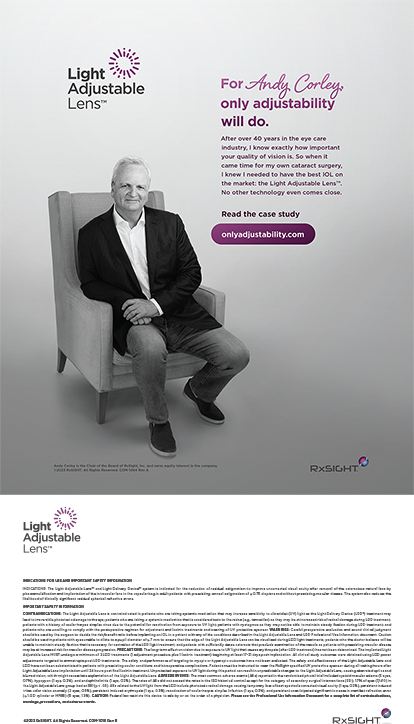Clear corneal incisions allow for quick, sutureless surgery and rapid visual rehabilitation after phacoemulsification. I do not feel, however, that slightly faster surgery counterbalances the potentially higher risk of endophthalmitis.
RISK OF ENDOPHTHALMITIS
The pathogens responsible for endophthalmitis can only enter the eye through the incision in the ocular surface. Recent reports on an increased incidence of endophthalmitis with clear corneal incisions, however, reveal that, despite the use of newer antibiotic prophylaxis, a significant percentage (25 to 33) of cases occur later than 1 week postoperatively.1,2
McDonnell and others have demonstrated that a reduction in the IOP after surgery can result in poor apposition of the edges of the clear corneal incision, with the potential for fluid to flow across the cornea and into the anterior chamber, thus increasing the risk of endophthalmitis.3,4 Surgeons can decrease this risk by rapidly closing the external wound with a suture or covering it with conjunctiva. Until the incision has sealed completely, the instillation of a rapidly active, broad-spectrum antibiotic is essential to maintaining the surface's sterility.
An issue, however, is that the majority of today's cataract surgeons prefer a uniplanar or straight stab incision. More than 10 years ago, Langerman demonstrated that a uniplanar incision will readily leak with focused pressure on its posterior lip.5 The egress of fluid will not necessarily occur at the end of the procedure, when significant corneal edema can make the wound appear to be well sealed. Testing the incision on the next day by pressing a cotton-tipped applicator on the posterior aspect of the wound will produce a leak. For a temporally placed incision, the exact same pressure can be achieved when the patient rubs a knuckle over the lateral aspect of his eye. In other words, temporal clear corneal incisions pose the highest risk of patient-induced brief leakage with subsequent hypotony.
Until the eye pressurizes, fluid and any pathogens present on the ocular surface can be drawn into the anterior chamber. This mechanism probably accounts for the appearance of virulent endophthalmitis beyond 1 week after cataract surgery with a clear corneal incision.1,2
THE TRIPLANAR INCISION
Langerman showed that a properly executed triplanar or Langerman hinge is extremely stable and does not leak when pressure is applied to its posterior lip.5 I routinely place this incision at the superior limbus and cover it with conjunctiva when performing cataract surgery. I begin by turning down the conjunctiva superiorly or superotemporally while taking care to leave the Tenon's insertion intact. I generally incise the conjunctiva 1 to 2 mm anterior to the Tenon's insertion to create access to the surgical limbus without opening Tenon's capsule. At the surgical limbus or the blue line, I use a crescent knife to make a deep vertical incision with an aim of 80 to 90 of full thickness. I then come up off the base and tunnel horizontally into clear cornea for approximately 1.5 mm. I make the final part of the incision with a 2.6-mm slit blade that enters along the same plane and then plunges as straight as possible into the anterior chamber to create a triplanar incision.
After completing the procedure, I pull the conjunctiva back over the external incision and pinch it closed with light cautery. The slight foreign body sensation my patients feel from the pinched closing of the conjunctiva is no worse than what they experience with the clear corneal incision.
In a significant majority of my patients, the conjunctiva will remain over the cataract incision. In a few cases, there is some conjunctival retraction, and the edge of the wound is exposed. Most will be fully covered by conjunctiva, however, within the first 5 to 8 days postoperatively. If conjunctiva has fully sealed the incision at this point, I will stop the topical antibiotic. If there has been any retraction or I can still see the external opening of the wound, I will prescribe antibiotics for an additional week.
Because of their location and the presence of blood vessels, I believe that my preferred cataract incisions heal much more quickly than those made in clear cornea. I therefore prefer to place my cataract incisions at the surgical limbus using a triplanar configuration and cover them with conjunctiva. In glaucoma patients who have filtering blebs or may need filtering surgery, however, I perform clear corneal incisions but always place a suture.
CONCLUSION
I have not observed any real benefit to patients from the uniplanar, clear corneal incision compared with the more stable, triplanar incision described by Langerman5 and placed beneath the conjunctiva at the surgical limbus. I can even use my incision with a temporal approach when circumstances (eg, ocular anatomy) warrant such an approach. Any time saved by the clear corneal incision cannot justify the increased risk to patients of potentially devastating endophthalmitis.
John R. Wittpenn, Jr, MD, is Associate Clinical Professor at the State University of New York in Stony Brook. Dr. Wittpenn may be reached at (631) 941-3363; jrwittpenn@aol.com.


